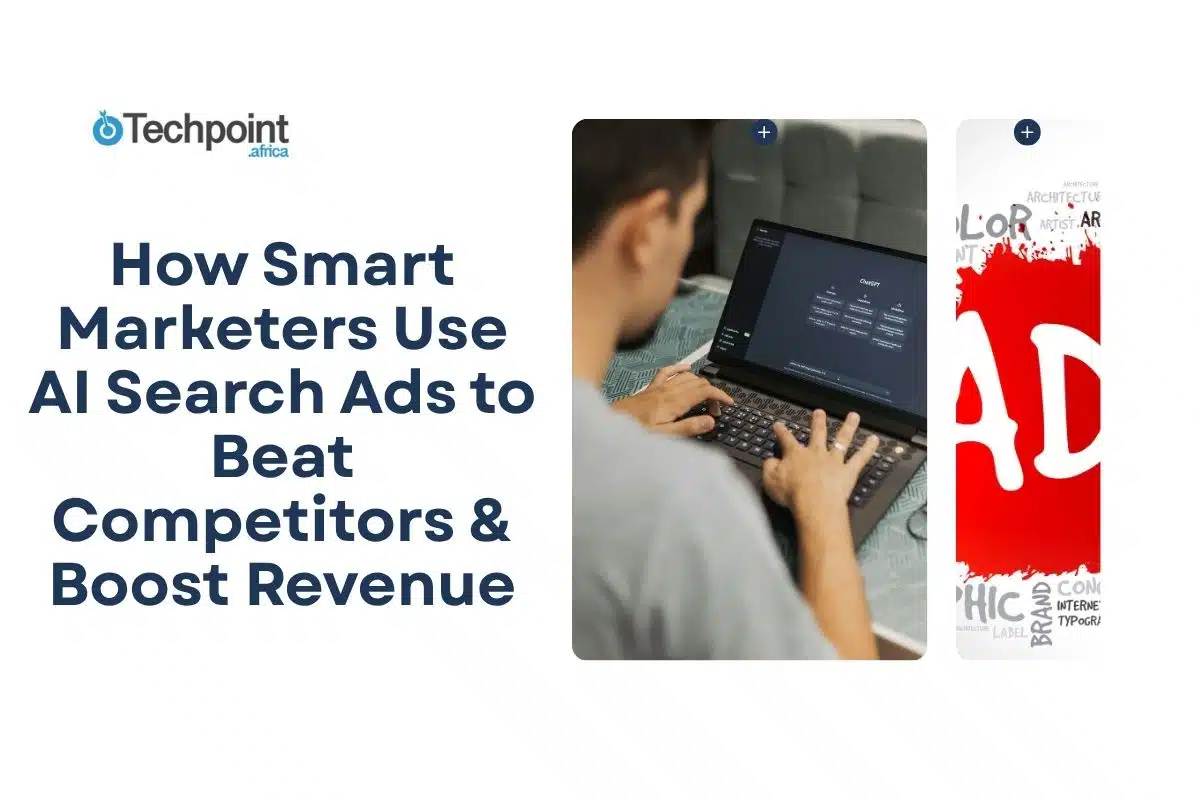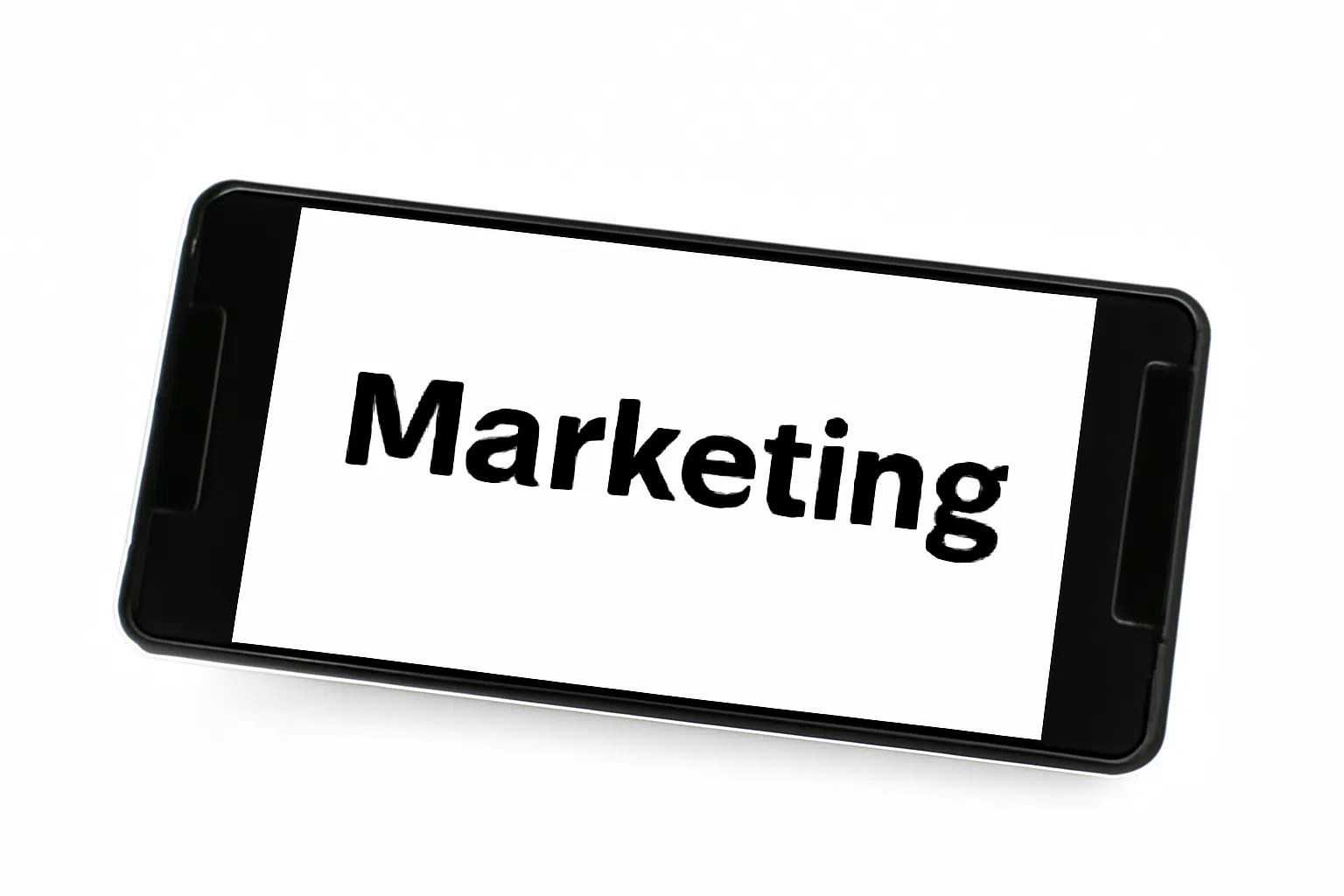
AI-powered search ads have transformed digital marketing by automating optimization, enhancing targeting, and delivering personalized experiences at scale. Savvy marketers have jumped on this fast-moving train to meet potential buyers, offer services to eager clients, and make KPI roll calls more fun for the guys on the sales side of things.
But AI-powered search ads execution is serious business. It’s not a 100% pushover task for AI alone. Several marketers assumed it was, only to find themselves struggling with tedious KPIs and disappointing results, often realizing this too late.
This article ensures you won’t be one of those marketers. Below, you’ll find the latest practical and effective ways to set clear business goals, prepare your campaigns, avoid common mistakes, and leverage AI-powered search ads to drive meaningful growth. Plus, we’ll explore the future of AI in search advertising and how you can stay ahead of the curve.
Let’s unwrap some gold!
What are AI-powered search ads?
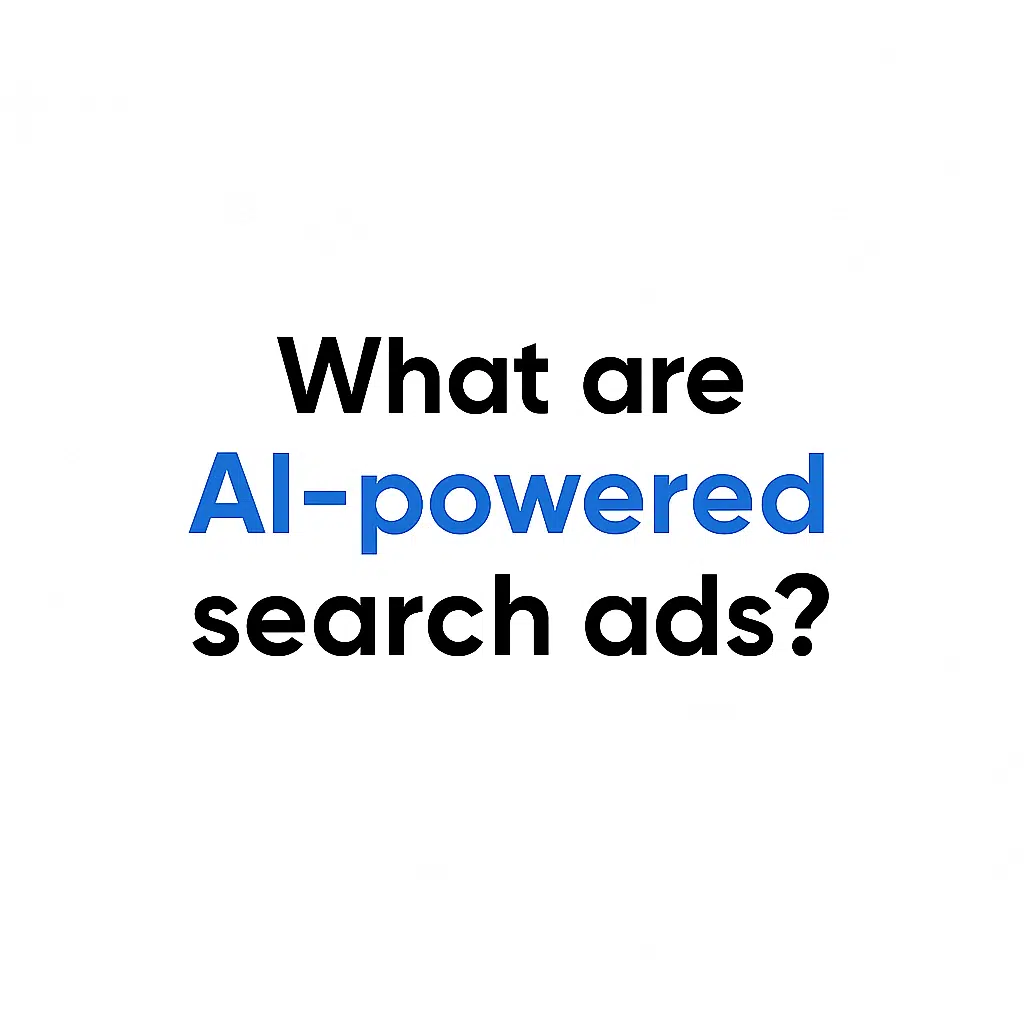
AI-powered search ads are a new, innovative way for marketers to advertise online. Instead of manually setting bids, choosing keywords, or guessing what customers want, marketers hand the ball to AI, which analyzes data from millions of searches and user behaviors to decide which ads to show, when, and to whom. This allows campaigns to reach the most relevant audience at the optimal moment without constant hands-on management.
The technology continuously learns and adapts, improving ad performance over time. This means marketers can focus on strategy and creativity, while AI handles the complex optimization behind the scenes. The result is a more effective use of the budget and better overall campaign results.
All these are happening so that at the end of AI-powered search ads, the technical side of advertising will be automated, freeing marketers to concentrate on what matters most: connecting with customers and achieving business goals.
Why traditional marketing is being shunned for AI-powered advertising
Traditional marketing methods have served businesses well for years, but they show their limits in the now-evolved digital space. The reception of AI-powered advertising is changing how marketers approach campaigns, offering more innovative and efficient alternatives. Here are the key reasons why many are moving away from traditional tactics in favor of AI-driven solutions:
| Challenge with Traditional Marketing | How AI Improves the Process |
| Manual processes slow down results | Traditional marketing depends heavily on manual tasks like setting bids, choosing keywords, and adjusting budgets. These steps take time and often rely on guesswork. In contrast, AI automates these processes, reacting instantly to changing data and saving valuable time. |
| Limited ability to handle complexity | Consumer behavior today is more complex than ever. People switch devices, use voice search, and expect personalized experiences. Traditional methods struggle to keep up with this complexity, while AI analyzes multiple signals simultaneously to deliver relevant ads tailored to each individual. |
| Delayed response to market changes | Traditional campaigns adjust only after data is collected and reviewed, which can take days or weeks. AI responds in real time, updating bids and targeting on the fly to capitalize on emerging trends or shifts in user intent. |
| Inefficient budget allocation | Without AI, marketers often spread budgets evenly or base their decisions on assumptions. AI identifies which audiences and keywords deliver the best value and reallocates spend dynamically, maximizing return on investment. |
| Reduced workload for marketers | Managing campaigns manually requires constant attention and testing. AI handles optimization continuously, freeing marketers to focus on strategy, creative ideas, and bigger-picture goals. |
| Better scalability | As campaigns grow in size and complexity, manual management becomes impractical. AI scales effortlessly, handling large datasets and multiple campaigns without losing efficiency. |
Because of these advantages, many marketers are shifting away from traditional marketing tactics and embracing AI-powered advertising to stay competitive and deliver better results.
How marketers benefit from AI-powered search ads for businesses
AI-powered search ads offer marketers several tangible advantages that help businesses grow more efficiently and effectively. As explained below, understanding these benefits reveals why AI has become an essential tool in modern advertising.
Improved targeting accuracy
AI processes vast amounts of data—from search queries and browsing habits to demographics and device types. This enables ads to reach the most relevant audience segments, those genuinely interested in the product or service. By identifying patterns and signals that humans might miss, AI reduces wasted impressions and increases the likelihood of conversion. For instance, it can detect users exhibiting behaviors similar to previous buyers, even if their search terms differ.
Real-time optimization
Unlike traditional campaigns that rely on manual updates, AI continuously monitors performance and makes instant adjustments. It automatically tweaks bids, refines targeting and tests various ad combinations to keep campaigns performing at their best throughout the day. This ongoing optimization reduces lag time and ensures ads remain competitive and cost-effective.
Cost efficiency
AI focuses the budget on high-performing keywords and audiences, minimizing spend on underperforming areas. Automated bidding strategies prioritize conversions or sales value rather than just clicks, maximizing the return on every marketing dollar. This approach benefits businesses of all sizes, allowing smaller advertisers to compete effectively without overspending.
Personalized ad experiences
AI tailors ad copy and creatives to match individual user intent and context. For example, depending on a user’s location, device, or past interactions, it might display different headlines or offers. This personalization makes ads more relevant and engaging, increasing the chances of user interaction and building stronger customer connections.
Scalability without extra effort
As campaigns grow, manual management becomes complex and time-consuming. AI effortlessly handles large datasets and multiple campaigns simultaneously, scaling marketing efforts without requiring additional human resources. This frees marketing teams to focus on strategy and creativity rather than routine tasks.
Insightful analytics and reporting
AI-powered tools provide detailed insights into campaign performance, revealing which keywords, audiences, and creatives drive results. These insights enable marketers to make smarter decisions and continuously improve their strategies, aligning advertising efforts closely with business goals.
When done consciously, applying these benefits, marketers can run campaigns that are more effective, efficient, and aligned with their objectives. AI-powered search ads free up time and resources, allowing teams to focus on growth and innovation.
Ways to set clear business goals for AI search ads
Setting clear business goals is essential for maximizing the impact of AI-powered search ads. Even the most advanced AI tools can struggle to deliver meaningful results without well-defined objectives. A focused approach helps ensure that AI optimization aligns directly with what matters most to the business. Here are key ways marketers can establish practical goals to guide their AI campaigns:
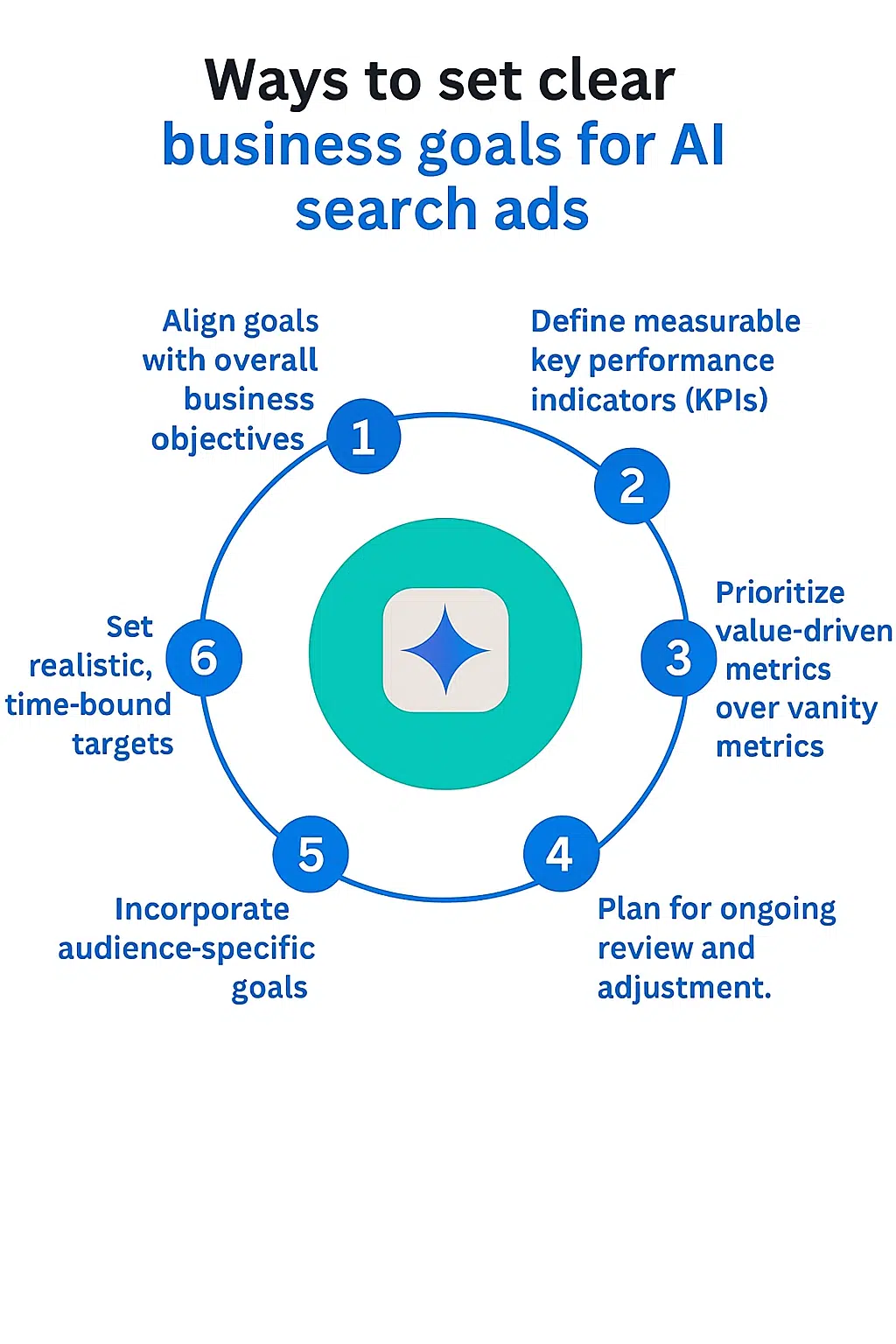
Align goals with overall business objectives
Start by connecting your advertising goals to the broader aims of the business. Whether the priority is increasing sales, generating qualified leads, building brand awareness, or driving website traffic, clarity on the ultimate purpose ensures AI focuses on outcomes that support growth. This alignment prevents wasted effort and keeps campaigns strategically relevant.
Define measurable key performance indicators (KPIs)
Goals must be quantifiable to track progress and success. Common KPIs include conversion volume, cost per acquisition (CPA), return on ad spend (ROAS), or average order value. These metrics provide clear benchmarks that AI uses to evaluate performance and adjust bidding, targeting, and creative strategies in real time. For example, if the goal is to increase ROAS by 15%, AI can prioritize budget allocation toward campaigns that deliver higher returns.
Prioritize value-driven metrics over vanity metrics
Clicks and impressions alone don’t guarantee business success. Instead, focus on metrics that reflect actual value, such as profit margins, customer lifetime value (LTV), or the quality of leads generated. Optimizing for these measures helps AI prioritize high-impact actions that improve the bottom line rather than just increasing traffic.
Plan for ongoing review and adjustment
Business conditions and priorities change, so goals should be revisited regularly. Continuous monitoring of campaign data allows marketers to refine objectives and align AI optimization with evolving strategies.
Incorporate audience-specific goals
If specific customer segments are more valuable, set goals around engagement or conversions within those groups. AI can then tailor bids and messaging to maximize impact on priority audiences, improving efficiency and relevance.
Set realistic, time-bound targets
Goals should be ambitious yet achievable within a specific timeframe. For example, aiming to boost conversions by 20% over the next quarter provides a clear target and deadline. This focus encourages consistent evaluation and course correction, ensuring campaigns stay on track.
By setting clear, measurable, and value-focused goals, marketers empower AI to act as a strategic partner. This clarity transforms AI from a simple automation tool into a driver of meaningful business growth.
How to prepare your marketing campaign for AI success
Launching a successful AI-powered search ad campaign starts with thorough preparation. AI tools are powerful but require the right conditions to perform optimally. Without careful setup, AI may struggle to deliver the expected results. Here are essential steps to prepare your marketing campaign for AI success:
Audit existing campaigns
Begin by reviewing your current search campaigns. Look for over-segmentation or excessive manual controls that might restrict AI’s ability to learn and optimize. Simplifying campaign structures and grouping related keywords helps AI analyze broader data sets, improving its effectiveness.
Consolidate campaigns by intent and theme
Organize campaigns around explicit user intents and thematic groups rather than narrow micro-segments. This approach provides AI with context, enabling it to better match ads to relevant queries and improve overall performance.
Enable broad match keywords and smart bidding
Broad match keywords allow AI to explore a wider range of relevant search queries beyond exact matches. When paired with innovative bidding strategies, AI can dynamically adjust bids based on real-time signals, maximizing conversions and return on investment.
Deploy responsive search ads
Responsive search ads let AI test multiple headlines and descriptions to find the most effective combinations. Providing diverse creative assets allows AI to optimize ad delivery for different audiences and search contexts.
Integrate first-party data and offline conversions
Uploading CRM data and enabling offline conversion tracking helps AI better understand your audience. This data allows AI to optimize for high-value customers and more meaningful conversions, not just clicks.
Set value-based goals
Define goals that focus on business outcomes such as profit, customer lifetime value, or qualified leads. Clear, value-driven objectives guide AI in prioritizing what truly matters to your business.
Plan for ongoing monitoring and iteration
AI campaigns require regular review and refinement. Use AI-powered reporting tools to track performance, identify opportunities, and adjust strategies. Continuous iteration ensures campaigns stay aligned with evolving business priorities.
By following these steps, marketers can create a strong foundation for AI to deliver meaningful results and maximize campaign success.
How should marketers use AI-powered search ads to accomplish their business goals?
Successfully using AI-powered search ads goes beyond setup—it requires strategy, ongoing management, and a clear focus on business outcomes. Marketers who apply AI effectively can unlock growth and efficiency. Below are key ways to use AI-powered search ads, illustrated with real-world examples:
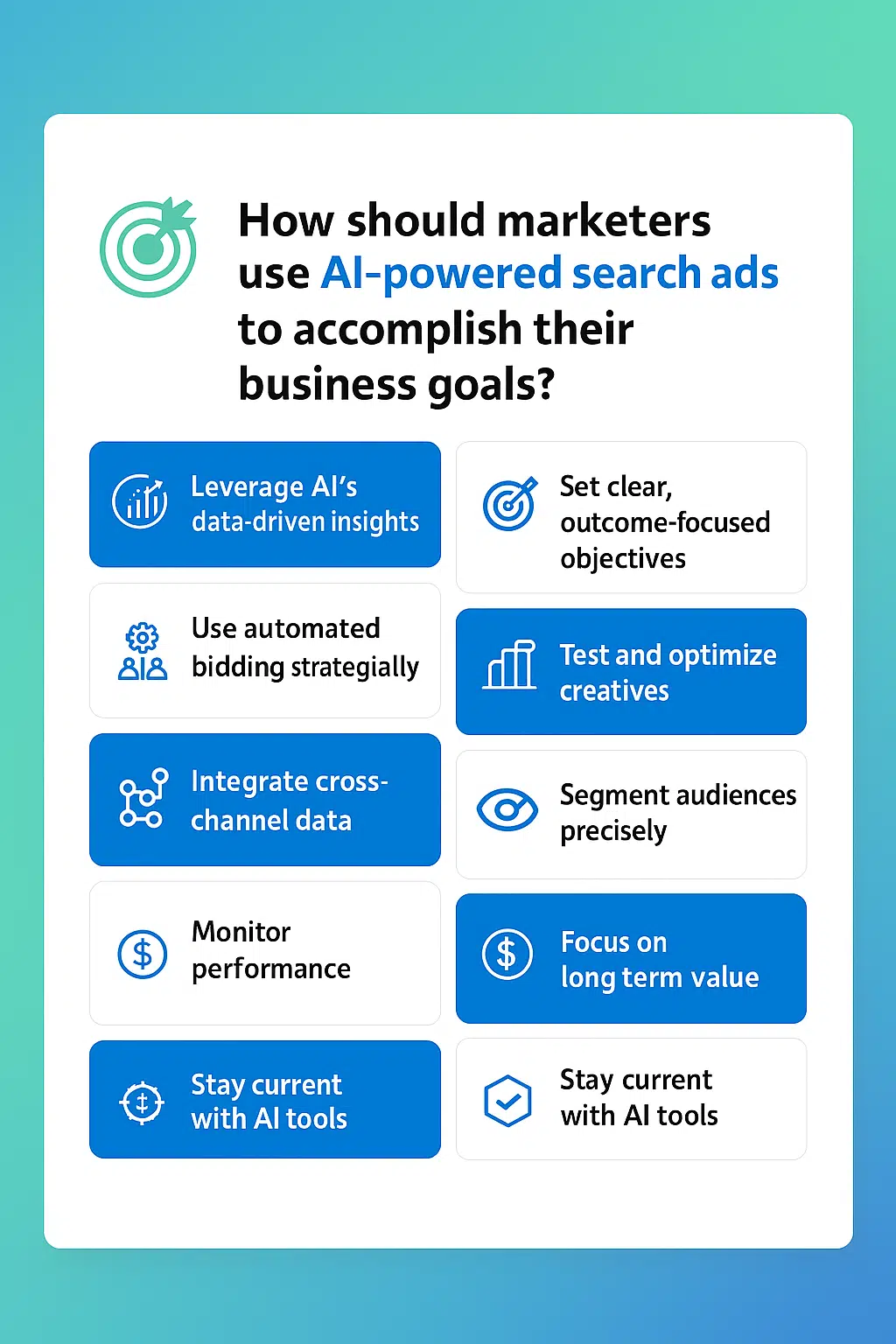
Leverage AI’s data-driven insights
AI processes huge volumes of data to spot patterns humans might miss. For instance, a travel company might discover through AI insights that weekend getaway searches spike on Thursday afternoons. Using this data, the marketer can adjust ad timing and messaging to capture this demand, increasing bookings without raising the budget.
Set clear, outcome-focused objectives
Before launching campaigns, define specific goals. A fitness brand, for example, might aim to increase online class sign-ups by 30% in three months. Clear objectives help AI optimize for meaningful results, rather than vanity metrics like clicks or impressions.
Utilize automated bidding strategies strategically
AI bidding strategies adapt bids based on real-time signals. A fashion retailer using Target ROAS can automatically increase bids on high-margin products during sales events, maximizing revenue. Meanwhile, a SaaS company might use Maximize Conversions to drive free trial sign-ups, adjusting bids to reach more qualified leads.
Test and optimize ad creatives continuously
Responsive search ads allow AI to test multiple headlines and descriptions. For example, a local restaurant might offer various offers—discounts, new menu items, or event promotions—and AI will identify which resonates best with different audiences, improving click-through and reservation rates.
Integrate cross-channel data for holistic optimization
AI performs better with a full view of customer journeys. For example, a consumer electronics company might combine search ad data with email campaign results, enabling AI to allocate budget toward audiences who engage across channels, increasing overall sales.
Segment audiences for precision targeting
Audience segmentation lets AI tailor ads effectively. A luxury car brand could target previous website visitors differently from first-time browsers, showing exclusive offers to loyal customers while educating new prospects with brand stories.
Monitor performance and adjust based on insights
Human oversight is vital. For example, a fashion marketer might track which shoe styles advertised are selling best and shift the budget accordingly. If boots outperform sneakers, AI can be guided to prioritize boot-related keywords and creatives, boosting ROI.
Focus on long-term value, not just immediate results
AI can optimize for lifetime value. A subscription box service may use AI to identify customers who consistently reorder and target similar profiles, ensuring marketing spend builds sustainable revenue rather than one-time sales.
Stay updated with AI advancements and platform features
AI tools change speedily, never static. A digital marketing team for a healthcare provider might adopt new Google Ads features like Performance Max campaigns early, gaining a competitive edge by reaching patients across multiple channels with minimal extra effort.
By adopting these practices, marketers can fully use AI-powered search ads to meet and exceed their business goals. Combining AI automation with strategic human input creates campaigns that are both efficient and effective, driving sustained growth.
Common mistakes and how marketers should avoid them when using AI for search ads
While AI-powered search ads offer powerful advantages, marketers can fall into common pitfalls that reduce effectiveness or waste budget. Recognizing and avoiding these mistakes ensures campaigns deliver optimal results. They include:
Over-reliance on automation without oversight
AI automates bidding, targeting, and optimization, but it is not infallible. Treating AI as a “set and forget” tool leads to missed opportunities and wasted budget. For example, AI might allocate spend to underperforming keywords or fail to respond to sudden market changes. Marketers must regularly monitor campaign performance, review AI-driven decisions, and intervene when necessary to keep campaigns aligned with business goals.
Setting vague or unrealistic goals
AI requires clear, measurable objectives to optimize effectively. Goals like “increase website traffic” without specifying conversion rates or revenue targets provide insufficient guidance. Similarly, setting unattainable goals can cause misaligned AI behavior and marketer frustration. Defining precise key performance indicators (KPIs)—such as cost per acquisition (CPA), return on ad spend (ROAS), or lead quality—ensures AI focuses on outcomes that matter.
Neglecting data quality and integration
AI’s learning depends on accurate and comprehensive data. Poor tracking setups, incomplete conversion tracking, or lack of integration with customer relationship management (CRM) systems limit AI’s ability to optimize. For instance, AI may undervalue specific keywords or audiences if offline sales or multi-channel conversions are not tracked. Ensuring robust data collection and integrating offline and online data streams empower AI to make better-informed decisions.
Over-segmentation of campaigns
Fragmenting campaigns into too many narrow ad groups or keyword sets restricts AI’s ability to gather sufficient data for learning and optimization. This can lead to slower performance improvements and inefficient budget use. Instead, marketers should consolidate related keywords and audiences into broader groups, providing AI with richer datasets to identify patterns and optimize effectively.
Insufficient creative diversity
AI-driven ad optimization relies on testing multiple headlines and descriptions. Providing limited or repetitive creatives reduces AI’s capacity to identify the best-performing combinations. Marketers should supply varied, relevant ad assets to enable continuous testing and improvement, enhancing engagement and conversion rates.
Ignoring AI-generated insights
AI platforms offer valuable analytics and recommendations. Disregarding these insights or resisting change limits campaign growth. Marketers should actively analyze AI feedback, experiment with suggested adjustments, and refine campaigns based on data-driven evidence.
By recognizing and addressing these common pitfalls, marketers can harness AI-powered search ads to deliver efficient, scalable, and results-driven campaigns that align with business objectives.
The future of AI-powered search ads and what marketers should expect
AI-powered search ads continue to transform how marketers connect with their audiences and optimize campaigns. To navigate this fast-changing environment effectively, it’s important to recognize key developments shaping the future of AI advertising. Understanding these trends will help marketers prepare and adapt their strategies to maintain a competitive advantage. Below are some of the most significant advancements and shifts marketers should expect as AI-powered search ads evolve.
Increased automation with greater control
Future AI tools will offer even more automation capabilities, handling complex tasks like budget allocation, audience segmentation, and creative optimization. However, marketers will retain greater control through customizable parameters and strategic inputs. This balance allows AI to operate efficiently while aligning closely with business goals.
Advanced predictive analytics
AI will increasingly leverage predictive analytics to forecast customer behavior and market trends. Marketers can expect tools that anticipate demand spikes, identify emerging keywords, and suggest proactive campaign adjustments. This foresight enables more agile and effective advertising strategies.
Deeper personalization at scale
AI-powered ads will deliver hyper-personalized experiences by analyzing real-time data across multiple channels. Marketers can tailor messaging, offers, and creatives to individual preferences and contexts, driving higher engagement and conversion rates.
Integration of voice and visual search
As voice assistants and visual search technologies grow, AI will optimize ads for these formats. Marketers should prepare for campaigns that target voice queries and image-based searches, expanding reach and relevance in new ways.
Cross-channel and omnichannel optimization
AI will unify data from search, social, video, and offline channels to provide holistic campaign management. This integration allows marketers to allocate budgets dynamically, measure accurate attribution, and deliver consistent messaging across touchpoints.
Ethical AI and transparency
With AI’s growing influence, ethical considerations and transparency will become paramount. Marketers must ensure data privacy, avoid bias in targeting, and maintain clear communication with consumers about AI-driven advertising practices.
Continuous learning and adaptation
AI systems will become more adaptive, learning from each campaign’s unique data to improve over time. Marketers should embrace iterative testing and refinement, leveraging AI’s evolving capabilities to stay ahead.
By anticipating these trends, marketers can position themselves perfectly and enjoy the full perks of AI-powered search ads. Staying informed and adaptable will be key to unlocking sustained growth and competitive advantage in digital marketing.
How marketers can keep pace with the future of AI-powered search ads
Keeping up with the advancements in AI-powered search ads requires marketers to be proactive and adaptable. Rather than simply reacting to changes, adopting deliberate strategies will help maintain campaign effectiveness and capitalize on new capabilities.
First, marketers should commit to continuous learning. Staying informed about platform updates, new AI features, and industry best practices ensures they can effectively apply the latest tools. Subscribing to trusted marketing publications, attending webinars, and participating in professional communities are practical ways to stay current.
Second, testing and experimentation remain essential. AI tools provide opportunities to try new bidding strategies, ad formats, and targeting options. Marketers should allocate time and budget to pilot these innovations, analyzing results to determine what works best for their audience and goals.
Third, maintaining clean and comprehensive data is critical. Accurate conversion tracking, integration of offline and online data, and regular audits of tracking setups allow AI to make better-informed decisions. Marketers should prioritize data hygiene to maximize AI’s optimization capabilities.
Fourth, collaboration between human insight and AI automation is key. While AI handles routine optimization, marketers must interpret results, make strategic adjustments, and provide creative direction. This partnership ensures campaigns align with business priorities and respond to market shifts.
Fifth, flexibility in goal setting helps marketers adapt to changing conditions. Revisiting and refining objectives based on performance data and market trends allows AI to continuously optimize toward relevant outcomes.
Finally, marketers should prioritize transparency and ethical practices. Being clear with customers about data usage and AI’s role in advertising builds trust and supports long-term brand reputation.
Through careful reception to these approaches, marketers can confidently navigate the evolving AI advertising environment and sustain strong campaign performance.
So,
You now know how AI-powered search ads provide marketers with unparalleled opportunities to reach the right audiences, optimize campaigns efficiently, and drive meaningful business growth. However, success goes beyond automation; it requires setting clear goals, strategic preparation, and continuous oversight.
As AI continues to advance, staying on trend and adaptable becomes essential. Marketers who consistently combine AI’s strengths with human insight stand a great chance of outperforming competitors, building sustainable growth, and deepening customer relationships.
Eager to take your search advertising to the next level? Start by defining your business goals clearly, embrace AI tools thoughtfully, and monitor your campaigns closely. With the right approach, AI-powered search ads can become your most powerful asset in driving revenue and staying two steps ahead in today’s competitive digital market.
Frequently Asked Questions (FAQs) about AI-powered search ads
1. How does AI impact keyword research for search ads?
- AI streamlines keyword research by analyzing large datasets to identify relevant keywords and search trends. It can discover long-tail and emerging keywords that manual research might miss, helping marketers target more precise queries and expand reach efficiently.
2. Are AI-powered search ads compatible with existing Google Ads campaigns?
- Yes. AI-powered search ads integrate with existing campaigns, such as those using broad match and smart bidding. Google’s AI systems prioritize ads with the highest Ad Rank across campaigns, ensuring the best-performing ads serve users. Features like AI Max for Search campaigns build on existing tools like Dynamic Search Ads and Performance Max.
3. What role does machine learning play in AI-powered search ads?
- Machine learning enables AI systems to learn from campaign data continuously, improving bidding strategies, targeting, and ad delivery without explicit programming. Over time, the system adapts to changing user behavior and market conditions, enhancing campaign performance.
4. How can marketers measure the success of AI-powered search ads?
- Success is measured through key performance indicators (KPIs) aligned with business goals, such as conversion rate, cost per acquisition (CPA), return on ad spend (ROAS), and customer lifetime value (LTV). Marketers should use these metrics to evaluate AI effectiveness and guide optimization.
5. Are AI-powered search ads suitable for all industries?
- AI-powered search ads are versatile and can benefit most industries by improving targeting and efficiency. However, industries with highly specialized or regulated products may require additional oversight to ensure compliance and appropriate messaging.
6. How does AI handle budget allocation across multiple campaigns?
- AI dynamically allocates budgets based on real-time performance data, shifting spending toward campaigns, keywords, or audiences that deliver the best results. This flexibility maximizes overall return by prioritizing high-impact opportunities.
7. Can AI-powered search ads help improve ad relevance and user experience?
- Yes. AI analyzes user intent and context to deliver ads that closely match search queries and user preferences. This relevance increases engagement, reduces bounce rates, and improves overall user satisfaction.
8. What are the privacy considerations when using AI in search advertising?
- Marketers must comply with data privacy regulations like GDPR and CCPA when collecting and using customer data for AI optimization. Transparency about data usage and obtaining user consent are critical to maintaining trust and legal compliance.
9. How do AI-powered search ads integrate with other digital marketing channels?
- AI can coordinate search ads with social media, display, email, and video campaigns by sharing audience data and performance insights. This integration enables cohesive messaging and more efficient budget allocation across channels.
10. How do AI-powered search ads differ from traditional search ads?
- Traditional search ads rely heavily on manual keyword selection, bidding, and ad copy management. AI-powered search ads automate these processes using machine learning to optimize bids, match ads to a broader range of relevant queries, and personalize creatives dynamically, resulting in more efficient and scalable campaigns.

